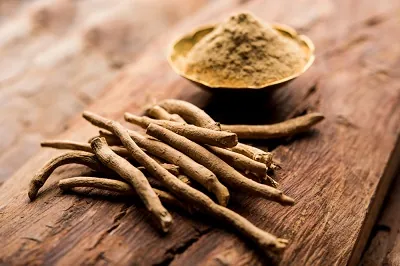Ashwagandha: Benefits, Uses, and Side Effects
Ashwagandha supplements have become popular in recent years and are frequently touted as an important part of healthy lifestyles. Here is what the science says about this supplement.
A supplement rooted in traditional medicine
Ashwagandha, also known as winter cherry, is an herb native to the Indian subcontinent. It has long been a centerpiece in the vast repertoire of natural remedies and has been used for centuries.
Often referred to as “Indian ginseng”, Ashwagandha is not merely a supplement. It has a 3,000-year history as being part of Ayurveda and is steeped in cultural and historical significance. As it has been a cornerstone in traditional medicine, it has been used to treat a myriad of ailments ranging from stress to inflammation [1].
Ashwagandha, a Sanskrit word meaning “smell of the horse”, was believed to give the strength and vitality of a stallion [2]. The classic texts of Ayurveda extolled its virtues as a potent “rasayana”, meaning restorative herb [3]. Ayurveda practitioners believe it to promote longevity and holistic well-being. Ashwagandha has also found a place in Middle Eastern and African traditional medicine [4, 5].
Ashwagandha is marketed as standardized capsules, raw powder, and tea infusions. While capsules offer convenience, traditionalists often lean toward the powdered root and blend it into warm milk for enhanced absorption.
What is ashwagandha?
 Ashwagandha (Withania Somnifera) is a small shrub with velvety, branched stems and simple, ovate leaves. Its distinct red berries, enclosed in a lantern-like calyx, often draw attention. However, it’s the roots that are of the most scientific interest.
Ashwagandha (Withania Somnifera) is a small shrub with velvety, branched stems and simple, ovate leaves. Its distinct red berries, enclosed in a lantern-like calyx, often draw attention. However, it’s the roots that are of the most scientific interest.
Thriving primarily in the arid regions of India, the Middle East, and Northern Africa, it is remarkably drought-resistant and adaptable, flourishing in challenging environments.
Potential benefits
Ashwagandha has several potent bioactive constituents. Among these, withanolides, which are naturally occurring steroidal lactones, take center stage [6]. Specifically, withaferin A and withanolide D have been found to be the primary drivers behind ashwagandha’s various health benefits [7].
While the herb contains many alkaloids, saponins, and amino acids [8], it’s the withanolides that are most interesting to modern researchers. These compounds modulate pathways in the human body in a way that may impact health outcomes.
Understanding the interplay of withanolides with physiological systems sheds light on ashwagandha’s enduring presence in traditional medicine. Ashwagandha’s reported health benefits primarily include reduced stress and anxiety, improved cognitive and neurological function, and enhanced immune function.
The herb exerts its effects by regulating cortisol [9], the body’s primary stress hormone. Elevated cortisol levels, which accompany chronic stress, can wreak havoc on bodily systems [10]. Ashwagandha’s role in normalizing these levels provides a biological foundation for its anti-stress claims.
 Cognitive and neurological health may also benefit from ashwagandha. Several studies have unearthed its potential in not just halting cognitive decline [11], but, in some cases, even reversing it [12].
Cognitive and neurological health may also benefit from ashwagandha. Several studies have unearthed its potential in not just halting cognitive decline [11], but, in some cases, even reversing it [12].
By modulating neural pathways, fostering the growth of neurons, and protecting the brain [13, 14], ashwagandha may be useful for conditions such as Alzheimer’s and Parkinson’s [15].
The immune system may also be be bolstered by ashwagandha. With its ability to manipulate the immune system, the herb enhances the creation of lymphocytes and white blood cells vital for immune response [16].
This effect does not seem to be transient; instead, ashwagandha appears to boost the body’s inherent defense systems [17]. It has also been reported to have anti-inflammatory benefits, likely due to its ability to block pro-inflammatory signals [18]. Anecdotally as well as clinically, there have also been reports of improved strength, stamina, and overall health with use [19, 20].
Ashwagandha is being explored in the fields of neuropsychiatry and immunology [21]. There are also recent studies that are exploring its anti-cancer properties [22].
Side effects
While ashwagandha can be beneficial, it had some potential adverse effects. Excessive consumption can lead to symptoms like constipation, bloating, reflux, nausea, vomiting, diarrhea, abdominal pain, and cramps. It can even lead to more subtle symptoms such as drowsiness.
In terms of reproductive health, pregnant and breastfeeding women are often advised to exercise caution, with some professionals recommending complete avoidance.
Half a gram to a gram appears to be a safe dose of ashwagandha. However, people with medical conditions or prescriptions should consult with healthcare providers before taking it [23].
Disclaimer
This article is only a very brief summary, is not intended as an exhaustive guide, and is based on the interpretation of research data, which is speculative by nature. This article is not a substitute for consulting your physician about which supplements may or may not be right for you. We do not endorse supplement use or any product or supplement vendor, and all discussion here is for scientific interest.
Literature
[1] Kulkarni, S.K.; Dhir, A. Withania Somnifera: An Indian Ginseng. Prog Neuropsychopharmacol Biol Psychiatry 2008, 32, 1093–1105
[2] Raithak, S.K.; More, D.B.; Pansare, T.A.; Chandil, S. A Review on Ayurvedic Plant Ashwagandha (Withania Somnifera) In Classical Literature. Certified Journal ¦ Raithak et al. World Journal of Pharmaceutical Research 2021, 10, 1275
[3] Singh, N.; Bhalla, M.; de Jager, P.; Gilca, M. An Overview on Ashwagandha: A Rasayana (Rejuvenator) of Ayurveda. African Journal of Traditional, Complementary and Alternative Medicines 2011, 8, 208–213
[4] Afewerky, H.K.; Ayodeji, A.E.; Tiamiyu, B.B.; Orege, J.I.; Okeke, E.S.; Oyejobi, A.O.; Bate, P.N.N.; Adeyemi, S.B. Critical Review of the Withania Somnifera (L.) Dunal: Ethnobotany, Pharmacological Efficacy, and Commercialization Significance in Africa. Bull Natl Res Cent 2021, 45, 176
[5] NCCIH Ashwagandha | NCCIH (accessed on 21 October 2023).
[6] Misico, R.I.; Nicotra, V.E.; Oberti, J.C.; Barboza, G.; Gil, R.R.; Burton, G. Withanolides and Related Steroids. Fortschr Chem Org Naturst 2011, 94, 127–229.
[7] Wijeratne, E.M.K.; Oliveira, M.C.F.; Mafezoli, J.; Xu, Y.M.; Minguzzi, S.; Batista, P.H.J.; Pessoa, O.D.L.; Whitesell, L.; Gunatilaka, A.A.L. Withaferin A and Withanolide D Analogues with Dual Heat-Shock-Inducing and Cytotoxic Activities: Semisynthesis and Biological Evaluation. J Nat Prod 2018, 81, 825–837
[8] Sukumar, Dr.B.S.; B., Dr.T.T.; H.K., Dr.S. Phyto Physico-Chemical Profile of Ashwagandha (Withania Somnifera Dunal). Journal of Ayurveda and Integrated Medical Sciences 2020, 5, 120–129
[9] Salve, J.; Pate, S.; Debnath, K.; Langade, D. Adaptogenic and Anxiolytic Effects of Ashwagandha Root Extract in Healthy Adults: A-Blind, Randomized, Placebo-Controlled Study. 2019
[10]. L, T.; J, G.; S, S. Physiology, Cortisol. StatPearls 2019.
[11] Choudhary, D.; Bhattacharyya, S.; Bose, S. Efficacy and Safety of Ashwagandha (Withania Somnifera (L.) Dunal) Root Extract in Improving Memory and Cognitive Functions. J Diet Suppl 2017, 14, 599–612
[12] Xing, D.; Yoo, C.; Gonzalez, D.; Jenkins, V.; Nottingham, K.; Dickerson, B.; Leonard, M.; Ko, J.; Faries, M.; Kephart, W.; et al. Effects of Acute Ashwagandha Ingestion on Cognitive Function. International Journal of Environmental Research and Public Health 2022, Vol. 19, Page 11852 2022
[13] Baitharu, I.; Jain, V.; Deep, S.N.; Shroff, S.; Sahu, J.K.; Naik, P.K.; Ilavazhagan, G. Withanolide A Prevents Neurodegeneration by Modulating Hippocampal Glutathione Biosynthesis during Hypoxia. PLoS One 2014
[14] Ahmad, M.; Saleem, S.; Ahmad, A.S.; Ansari, M.A.; Yousuf, S.; Hoda, M.N.; Islam, F. Neuroprotective Effects of Withania Somnifera on 6-Hydroxydopamine Induced Parkinsonism in Rats. Hum Exp Toxicol 2005, 24, 137–147
[15] Sandhir, R.; Sood, A. Neuroprotective Potential of Withania Somnifera (Ashwagandha) in Neurological Conditions. Science of Ashwagandha: Preventive and Therapeutic Potentials 2017, 373–387
[16] Mikolai, J.; Erlandsen, A.; Murison, A.; Brown, K.A.; Gregory, W.L.; Raman-Caplan, P.; Zwickey, H.L. In Vivo Effects of Ashwagandha (Withania Somnifera) Extract on the Activation of Lymphocytes. https://home.liebertpub.com/acm 2009, 15, 423–430
[17] Ziauddin, M.; Phansalkar, N.; Patki, P.; Diwanay, S.; Patwardhan, B. Studies on the Immunomodulatory Effects of Ashwagandha. J Ethnopharmacol 1996, 50, 69–76
[18] Ashwagandha Root Extract Exerts Anti-inflammatory Effects in HaCaT Cells by Inhibiting the MAPK/NF-?B Pathways and by Regulating Cytokines (accessed on 21 October 2023).
[19] Sandhu, J.; Shah, B.; Shenoy, S.; Padhi, M.; Chauhan, S.; Lavekar, G. Effects of Withania Somnifera (Ashwagandha) and Terminalia Arjuna (Arjuna) on Physical Performance and Cardiorespiratory Endurance in Healthy Young Adults. Int J Ayurveda Res 2010, 1, 144
[20] Wankhede, S.; Langade, D.; Joshi, K.; Sinha, S.R.; Bhattacharyya, S. Examining the Effect of Withania Somnifera Supplementation on Muscle Strength and Recovery: A Randomized Controlled Trial. J Int Soc Sports Nutr 2015, 12
[21] D’Cruz, M.; Andrade, C. Potential Clinical Applications of Ashwagandha (Withania Somnifera) in Medicine and Neuropsychiatry. Expert Rev Clin Pharmacol 2022, 15, 1067–1080.
[22] Mehta, V.; Chander, H.; Munshi, A. Mechanisms of Anti-Tumor Activity of Withania Somnifera (Ashwagandha). Nutr Cancer 2021, 73, 914–926
[23] Ashwagandha – Special Subjects – Merck Manuals Consumer Version (accessed on 21 October 2023).


